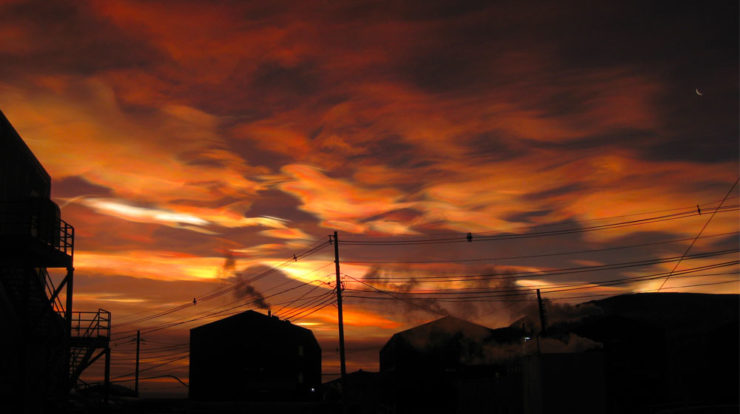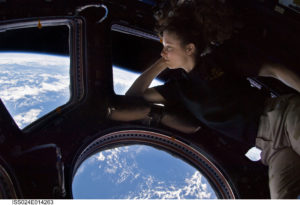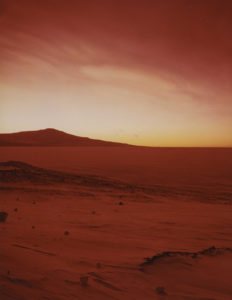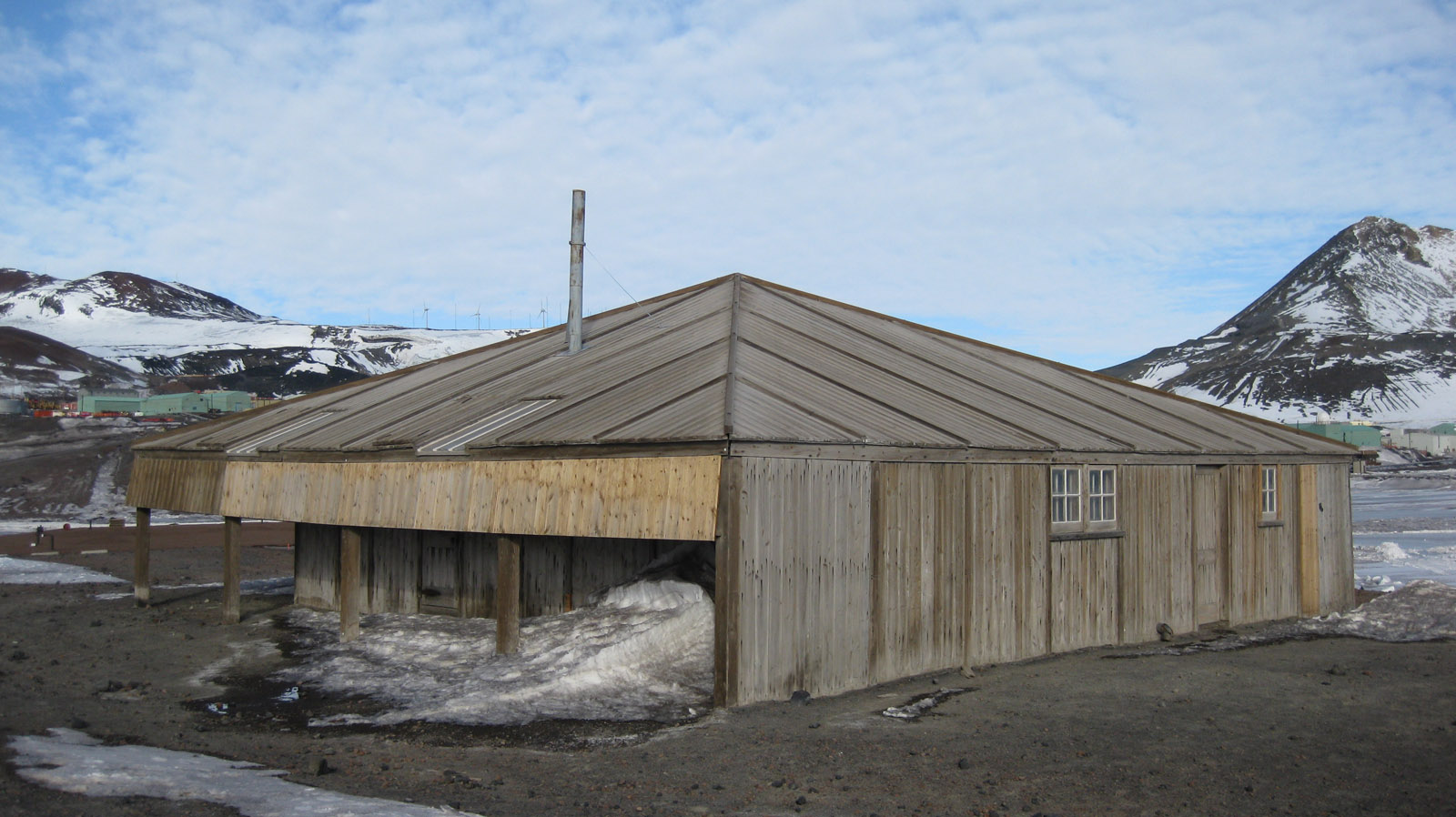

Features
Biophilia in an Abiotic Environment
Georgina Davis
Share
Originally I wanted this post to focus on the difficulty of trying to recreate off-planet the sensory experiences we value so much on Earth. I wanted to explore how we could address biophilia when we leave our planet —the source of all that is familiar to us. Astronauts comment on missing the sights, sounds, and smells of Earth while they are in space, and even the presence of a small plant can offer some relief. Because of space or energy limitations, this is sometimes all that is possible, but the innate tendency to seek nature becomes most apparent when we are deprived of it. It’s a reminder of how precious our planet is to us, and of our evolutionary link to the natural world at a deep psychological and physiological level.
I chose instead to shift the focus slightly, more towards something I could write about more directly: not space flight but one of its analogues, the extreme environment of Antarctica. Rather than ask how biophilia can influence the design of a completely artificial capsule environment (i.e., a long-term space vehicle), I will begin by exploring how biophilia and the 14 Patterns of Biophilic Design can be adapted for a place on this planet where the environment is more alien than viscerally familiar.
Forbidding Planet

Fig 1: NASA astronaut Tracy Caldwell Dyson, Expedition 24 flight engineer, looks through a window in the Cupola of the International Space Station.
While humans have reached nearly every corner of the surface of this planet, there are still inhospitable places where, without the slow process of evolutionary adaptation, we explore only as visitors aided by advances in technology. The ice-locked continent of Antarctica is one such place. It hosts no terrestrial mammals and most life is reliant on the relative shelter of its cold, rich oceans (-1.6oC). Non-adapted species like humans find little in the way of shelter and sustenance, and even short excursions require enormous planning and logistics.
Antarctica is a place where the built environment (e.g., a ship, a hut, research station, or tent) turns into a life raft; it grants us access to the area and may delay certain death, but unless its designers take into consideration both human psychological and physiological needs, it will not translate to a successful long-term habitation. Building solutions for health and safety must also address factors such as the need to stimulate our senses, including a desire to engage with nature, even (or especially) in a place where none may be found.
Sensory experiences we value so much in our everyday lives are often difficult, impossible, or impossibly expensive to replicate in extreme and remote areas like Antarctica. Those who set foot in the wide, Antarctic landscape will witness sights few others can imagine, but they will only be reminded how far they are from home (Fig. 2). There are no green forests or meadows; there is little chance of a cozy, wood-burning fire;1 most outings require heavy protective clothing or gear; while often spectacular, dawn and dusk will not occur on 24-hour cycles; and there are few chances for enjoying fresh food. The simple act of opening a window (or even having a window) that we so often take for granted, poses numerous problems.
This subconscious connection with nature tells the story of our evolution.2 As the social ecologist Stephen Kellert wrote,

Fig 2: Near White Island, Antarctica. The low light angles make this Antarctic sky look more like a Martian landscape.
“…biophilia and biophilic design emphasize the human need for experiential contact with nature that elicits our physical, emotional, and intellectual benefit and satisfaction” (Kellert, 2014).
For the people who spend several months in this extreme environment, biophilic design can offer a connection to nature for those living away from Earth’s more hospitable climes by creating a restorative environment instead of one that only adds to the stress or monotony of daily life. But what does it mean to make a connection between habitat and nature when the natural world outside the door is potentially deadly? With no plants or pets in a beautiful –but abiotic– vista, how can designers provide a connection to living things (or their analogues)? How often does technology –paradoxically– provide a solution? To what extent do we accept the beauty of the white, barren landscape, and stop pretending we’re somewhere else?
These are all important questions, and many are being addressed by the designers of modern Antarctic stations. As is often the case, this knowledge has been acquired through hard won trial and error, so a look back at a few missteps will help us see how today’s stations and the people who work there cope with these unusual conditions.
1 That is, unless you decide you need to burn parts of your wooden hut.
2 Naturally, the converse of Biophilia is Biophobia. It is important to differentiate between two uses of this term. Biophobia is used to describe an evolutionary advantageous negative response to things in nature that pose a threat (e.g., poisonous animals or a precipice). The term is also sometimes used to denote an aversion to all things in nature. Such a response is learned and is often present in those only familiar with mostly artificial environments (Salingaros, 2015).
Man in a White Hole
Antarctic buildings from the Heroic Age (1895-1917) were prefabricated wooden huts reassembled by teams of early explorers. These explorers were focused on the creation of an indoor environment that protected them from the elements. Like most exposed elements in Antarctica, they gradually became snow drifted (and those not built on solid ground began their inevitable descent into the moving ice sheet). Decades later, some of the first scientific stations erected by the U.S. Navy and other countries were wooden huts that were either allowed to be buried beneath snow or deliberately buried in excavated trenches (e.g., Byrd Station, the Little America camps, Germany’s Neumayer Station I-II, and the UK’s Halley Station I-IV). Burying a building in snow reduces heat loss, provides extra “interior” space, and makes for quieter quarters than if exposed to the howling wind.3
In Antarctica, unless one is located on a rare patch of exposed (frozen) ground, the act of burying a building seems to make sense.4 Such a design approach falls into the pattern of Refuge –protecting occupants from the outside world- but only in the short term. Living in a hole brings with it important downsides besides morale, including balancing thermal comfort with healthy ventilation and fire safety. With no exterior view or visual relief (a condition referred to as Prospect), the structure or structures run the risk of becoming claustrophobic, windowless boxes, especially when weather prevents outdoor activities or travel for days on end. Over the long term, this solution would be highly undesirable.5 Although snow tunnels still exist, no contemporary design for Antarctic stations are subnivean.
3 The hut and tunnels occupied by Norwegian explorer Roald Amundsen and his team in 1910-1911 were laid out like this, and the men who lived there enjoyed relative thermal comfort and adequate space for privacy, at least for several hours a day. The hut was left to the elements after the team’s successful trip to the South Pole and eventually lost to crushing snow and ice. Modern research stations, however, were intended to last longer, but even when reinforced and excavated annually, were unable to withstand the cumulative effects of blowing snow and a moving ice sheet. All were eventually abandoned.
4 Subsequent Antarctic stations were elevated above the snow or built on exposed ground, and most provided at least a few windows (some more than others). Halley V was raised several meters off the snow and featured small square windows. Casey station (aka, the Casey tunnel), an aerodynamically-designed raised station with an attached walkway sloping down the coast, offered a few small windows. Windows were not present in the design for the dome at South Pole, which was supposed to protect interior structures from snow accumulation but ultimately failed.
5 The Antarctic Treaty prohibits the importation of foreign species. No soil may be brought on continent, so the only plants that may grow are those cultivated in well insulated hydroponic greenhouses. Since the continent is a desert, the use of this technology must be carefully planned.
Ice House
While there is no history of vernacular architecture in Antarctica, the idea of building for local (climatic) conditions is understandably important when much of the year is spent in near total darkness at temperatures which can surpass -73oC. In the high Arctic, the classic image of a cold-weather shelter is the igloo, created with local materials (ice, snow, and animal hide), but there are also examples of larger and more modern Arctic settlements or cities. Often tightly clustered their colorful wood or metal exteriors contrast with the white surroundings; while sometimes above the treeline, using wood for interior finishes offers a material connection to nature while providing a sense of the Refuge condition.
Unfortunately, this idea was not always at the forefront of planning. On his Discovery expedition (1901-1904), Sir Robert Scott purchased a prefabricated hut to house the men all winter (Fig. 3). With its steep roof and veranda, it was designed for the warm, sunny climate of Australia. The walls were drafty and the heating element undersized. Ultimately the Discovery hut was used as storage and an emergency shelter (and sometimes a theater), while the men lived on the ship instead.
The Discovery hut (which you can still visit on Ross Island) is considered the least successful of the huts of the Heroic Era (1897-1922). It was never used as a shelter until Ernest Shackleton’s famous Endurance expedition, whose members unexpectedly had to live in it for several long, uncomfortable months. In addition to cramped quarters, the interior air quality deteriorated when the supply of candles ran out and the men turned to burning seal blubber for light and heat.6 When the same expedition again used the hut about a year later, conditions were no better, and with the supply of blubber running low, the men had to burn pieces hacked off the very building sheltering them from the cold. Today, examples of this kind of blindness to climate exist mostly as “legacy buildings,” decades old but only used out of necessity or nostalgia.
6 Unfortunately, burning seal blubber is not only odious but leaves a greasy film on everything: walls, clothing, skin, everything. Over time the interior of the hut turned a sooty black (Harrowfield, 1995, p. 35).
Opportunities for Biophilic Interventions
Today, new stations like Halley VI, South Pole Station, Princess Elisabeth station, and every modern Antarctic station are raised or built on solid ground and feature windows not just in common areas, but in most rooms and labs. This decision is based mostly in structural, mechanical, and logistical advantage, but is also essential for providing a connection to place that would be lost in a windowless building. However, from an engineering standpoint, windows are still weak points in otherwise well-insulated walls (e.g., R-70 vs R-10 or R-20). Therefore, windows must be carefully and deliberately placed for safety (near doors) and for specific views or daylighting opportunities (which may need to be covered during the darkest, coldest months).
This brings us to the biophilic pattern category Nature of the Space. Some stations are in locations with fantastic vistas (e.g., the sea ice, ocean, or mountain range) and nearly all stations will witness spectacular atmospheric conditions (e.g., auroras, nacreous clouds, fast moving weather), so the decision to place windows should be easy. Access to these views is highly sought after, not just because they reveal a distant landmark upon which to focus (rest) the eyes, but because it offers viewers Prospect (a view of the weather, or of the area outside the station’s borders) and Risk/Peril (it is always a risk to leave the station) from the heated safety of an interior space (Refuge).
Providing interior windows is another way to open up a building that may have several conditioned zones: for example, a central hydroponic greenhouse surrounded by lounge areas or corridors. Other site-specific examples include underwater observation tubes near the coast, which allow individuals access to the mysterious world under the sea ice, and rooms or buildings designed for viewing auroras in winter.
One conundrum brought on by the high latitude involves windows in dormitory rooms. Since rooms are small and intended mostly for sleeping, having a window presents a daylighting and thermal comfort problem. During the summer, light shines in all day, and windows tend to remain covered. During the winter it is often too dark to see out, and aging window frames tend to let in drafts, fine dust, or spindrift. For night shift workers, there is no useful configuration. Aside from fire safety issues, what is the value of a window in such a place? Are windows best reserved for common areas? Could artificial windows provide a satisfactory alternative by allowing room occupants a view outside without breaking the thermal barrier? As technology advances and the design challenges have evolved, different stations have explored a variety of approaches at their respective sites.
While a Visual Connection to Nature may be limited in an abiotic landscape, the biophilic pattern known as Non-Visual Connection to Nature also provides several ways to bring life into the otherwise sterile interior environment.
Gustatory
Always the subject of debate: food. Even for early explores, talking about the next meal was a phenomenon observed during times of severe boredom. This habit can be observed in today’s modern stations, when for some, the only change in daily routine is the menu, from which certain items are conspicuously absent. Most food is frozen or canned, menus planned and ingredients ordered months in advance. While plentiful and high in calories, it is not always the most satisfying (not through a lack of effort, but simply because of the extraordinary logistics). The shortage of fresh food goes to a larger problem faced in both large and small stations: a lack of variety and choice. Providing some semblance of choice at meal time is a small but meaningful step forward. There is little else to be done until the next breakthrough in food preservation, but all efforts to provide fresh vegetables should be supported. Another benefit of a hydroponic greenhouse would be increased access to fresh ingredients all year.
Olfactory
Not counting the smell of diesel, cleaning products, and mass-produced food, there are nearly no natural scents in Antarctica (Fig. 4). (The smell of the ocean and occasional animal feces are exceptions.) Indoor air quality should be the first concern, with access to both temperature control and humidification a high priority. Access to hydroponic greenhouses (as mentioned above) is an energy intensive but effective way to provide opportunities to smell something growing. Anyone who has spent a few months in Antarctica immediately comments on the pleasant smell of grass when they return home. Artificial methods (scent delivery) are a possibility, but with highly individual preference, this would need to be applied carefully (read more about olfaction and biophilic design).
Auditory
While true silence can itself be a rare, calming experience while working away from a station, most people do not get a chance to experience this. With a few exceptions, nature sounds are rare in Antarctica. Instead of the rustle of wind through leaves, it screams around buildings, bellows into vents, and sometimes turns open pipes into a haunting flute. While people enjoy opportunistically listening to seals and penguins, on a regular basis the biggest concern is protection from noise (e.g., wind, machinery and heavy equipment, helicopters, structure-borne sounds, or other people living in crowded conditions). Ensuring everyone has a chance to decompress at the end of the work day and listen to one’s own preference (e.g., silence, music, artificial nature sounds) is one way to unwind or help manage sleep cycles. It is not unreasonable to include virtual reality “escapes” that include soundscapes as part of a future solution.
Haptic
Bundled under layers of clothing, often suffering from cracked and dry skin, raw noses, and plagued by static shocks, anyone working in a cold, dry environment knows that surfaces and materials play an important role in occupant comfort, as does access to hot showers, saunas, or pools. Without humidification, mechanical heating lowers the relative humidity, leading to dry skin; frequent hand washing (to reduce the spread of communicable disease) only exacerbates this. Water scarcity is an energy and conservation problem needing further attention, but materials and indoor air quality low-hanging fruit which can provide substantial benefits.
Without having to worry about the effects of micro-gravity or the absence of a breathable atmosphere, working in the Antarctic may not be quite as extreme as working in outer space, but there are still parallels to living off-world. In a land nearly devoid of life, taking advantage of even small opportunities to create a connection to nature in creative ways —and not solely through visual connections— can have significant positive physiological effects.
In the next installment, I will explore more biophilic patterns and how they can be applied to Antarctic stations. These include the presence of water in a frozen land, connection with natural systems, and dynamic and diffuse lighting during 24 hours of darkness or light.
Fig 1: Photo courtesy USGS/Flickr, 2010.
Fig 2: Photo courtesy R.Davis, 1981.
Fig 3: Photo by G.Davis, 2015.
Fig 4: Photo by G.Davis, 2010.
Header image: Nacreous clouds in McMurdo. Photo by G.Davis, 2009.
References
Harrowfield, D. L. (1995). Icy heritage. Christchurch: Antarctic Heritage Trust.
Kellert, Stephen. (2014). Biophilia and biomimicry: evolutionary adaptation of human versus nonhuman nature. Intelligent Buildings International. 1-6. 10.1080/17508975.2014.902802.
Salingaros, Nikos A. (2015) “Biophilia and Healing Environments: Healthy Principles For Designing the Built World”. New York: Terrapin Bright Green, LLC.
Georgina Davis
is a research analyst at Terrapin and has a background in architecture and field research. She completed her master’s and doctoral degrees at Texas A&M University and her bachelor's at Washington University in St. Louis. Her interests include energy efficiency and occupant comfort in extreme environments and bio-inspired innovation.
Topics
- Environmental Values
- Speaking
- LEED
- Terrapin Team
- Phoebe
- Community Development
- Greenbuild
- Technology
- Biophilic Design Interactive
- Catie Ryan
- Spanish
- Hebrew
- French
- Portuguese
- Publications
- Occupant Comfort
- Materials Science
- Conference
- Psychoacoustics
- Education
- Workshop
- Mass Timber
- Transit
- Carbon Strategy
- connection with natural materials
- interior design
- inspirational hero
- biophilia
- economics of biophilia
- Sustainability
- wood
- case studies
- Systems Integration
- Biophilic Design
- Commercial
- Net Zero
- Resorts & Hospitality
- Energy Utilization
- Water Management
- Corporations and Institutions
- Institutional
- Ecosystem Science
- Green Guidelines
- Profitability
- Climate Resiliency
- Health & Wellbeing
- Indoor Environmental Quality
- Building Performance
- Bioinspired Innovation
- Biodiversity
- Residential
- Master Planning
- Architects and Designers
- Developers and Building Owners
- Governments and NGOs
- Urban Design
- Product Development
- Original Research
- Manufacturing
- Industrial Ecology
- Resource Management
- Sustainability Plans
- Health Care
- Carbon Neutrality




